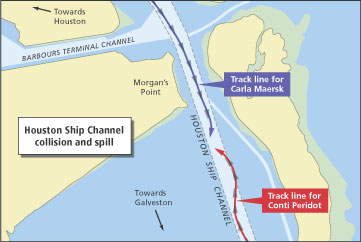A hazardous chemical leaked from a tanker that collided with a bulk carrier in the Houston Ship Channel. Two dock workers were taken to a hospital after being exposed to fumes.
The Danish chemical tanker Carla Maersk was damaged in the March 9 collision with Conti Peridot near Morgan’s Point. Fog and mist prevailed at the time.
The 623-foot, Liberian-flagged Conti Peridot was on its way to the Port of Houston when it collided with the 599-foot Carla Maersk near Buoys No. 89 and 90 at approximately 1231. The tanker was headed to Venezuela with 216,000 barrels of methyl tertiary butyl ether (MTBE). Two of Carla Maersk’s tanks were punctured, causing an unknown amount of MTBE to enter the channel. A flyover subsequently revealed a 2-mile-long sheen.
Conti Peridot, with a Houston pilot aboard, was inbound at 0930 to discharge steel rolls at City Dock 24. Meanwhile, Carla Maersk left Kinder Morgan Terminal in Galena Park, Texas, with a pilot on board. Conti Peridot was underway in good visibility, while Carla Maersk was sailing in light rain and low clouds, the National Transportation Safety Board (NTSB) said in a preliminary report on April 2.
Fog developed, and at 1130 Houston Pilots suspended pilot boardings at the channel’s entrance. Piloted vessels that were in transit continued on their trips.
At 1230, with visibility estimated to be a ship’s length, Conti Peridot and Carla Maersk were sailing at just over 8 knots as they neared one another south of Morgan’s Point. The pilot on Conti Peridot had trouble returning to the channel’s center after passing another vessel, the NTSB wrote. He initiated a port-to-port passing arrangement with the pilot on Carla Maersk.
“After this arrangement was made, preliminary data show the Conti Peridot moved to the left side of the channel and then back to the right. At this time, the Conti Peridot ordered hard-starboard and full-ahead in an effort to counter his vessel’s anticipated movement to the left,” the NTSB said in its summary.
“The pilot on the Conti Peridot warned the pilot on the Carla Maersk that he was coming back across the centerline of the channel toward his vessel,” the investigators wrote. “When the pilot on the Carla Maersk saw the bow of the Conti Peridot emerge from the fog, he ordered hard-starboard and full-ahead in an effort to avoid what he perceived to be an imminent collision.”
Conti Peridot’s bow struck the port side of Carla Maersk, penetrating the two port wing ballast tanks and the No. 4 port cargo tank. After the impact, the Maersk tanker developed a port list, and the crew moved cargo and ballast to correct the list. No injuries were reported on either vessel.
Maersk Group released a statement after the incident, saying it was working closely with the Coast Guard and making every effort to avoid any environmental impact. Most of the MTBE in Carla Maersk’s damaged tanks was transferred to other tanks on the vessel.
Coast Guard Capt. Brian Penoyer said the leak had been stopped 90 minutes after the collision and before it reached significant dimensions. MTBE, a flammable fuel additive with limited solubility in water, can impact air, water and human health, and it is banned as a gasoline additive in some states.
The Houston Ship Channel was closed from 1241 on March 9 until 0837 on March 12.
“A shelter in place was in effect from about 1 p.m. to 10 p.m. on March 9, affecting Barbours Cut Terminal and Morgan’s Point,” Coast Guard spokesman Dustin Williams said.
The channel reopened on the morning of March 12 after responders completed initial salvage work on the damaged tanker and moved it to the Barbours Cut turning basin, Williams said. “The structural integrity of the vessel was checked before it was moved,” he said. “High-density foam was used to suppress flammable vapors from the vessel’s damaged tanks. Extensive air monitoring around the ship showed no sign of vapors seeping from the vessel.”
Conti Peridot was moved to the Port of Houston Authority’s turning basin terminal.
In mid-March, responders continued to conduct air and water tests, which indicated no threats to the public or the environment, Williams said.
The NTSB, which sent investigators to the scene a day after the accident, will release a final report when its assessment is complete.

